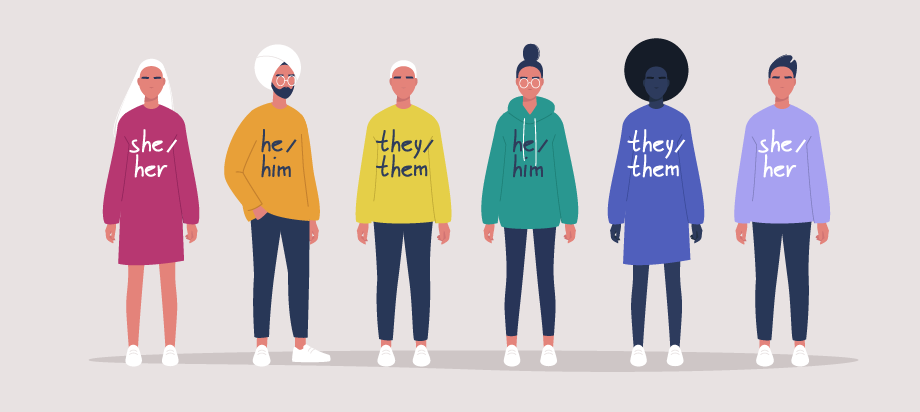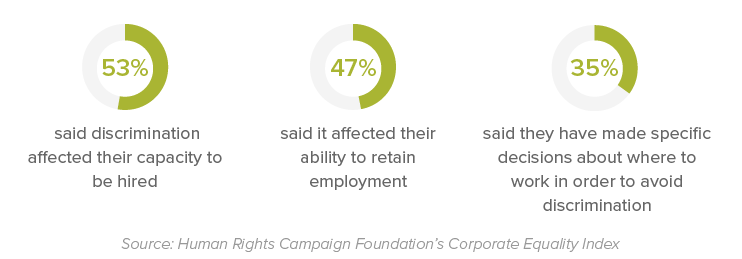 Like most companies, you’ve likely been grappling with the idea of using gender pronouns in the workplace.
Like most companies, you’ve likely been grappling with the idea of using gender pronouns in the workplace.
Should they be encouraged or required? It’s a slippery slope; you want to show company-wide support for your LGBTQIA employees, but forcing or pressuring the use of gender pronouns can backfire.
As we honor International Pronouns Day (October 20), there’s no better time to have these conversations internally and establish your company’s position on using gender pronouns.
Why Do Gender Pronouns Matter?
Think about the last time someone mispronounced your name. Now, what if that person continues to call you by the wrong name, especially after they’ve been corrected a couple of times? It starts to get annoying. And if they call you the wrong name in front of other people, it can be embarrassing … even belittling.
Now imagine that person referring to you as the wrong gender. If done repeatedly, the annoyance can quickly turn to the concern so many marginalized people have at work: “How safe do I feel being my true self at work? How much can I trust my company?”
It’s tough to create an inclusive workspace when employees don’t feel safe, seen, or validated.
And for many transgender or genderqueer (someone who is nonbinary, agender, pangender or genderfluid, for example) employees, that concern is very real: According to an American Progress report, 53% of transgender individuals said discrimination affected their capacity to be hired, while 47% said it affected their ability to retain employment. And 35% of LGBTQIA people said they have made specific decisions about where to work in order to avoid discrimination.
Despite some heartening progress in LGBTQIA workplace equality, there are still a lot of significant barriers to full inclusion. One of them is simple visibility. That’s where pronouns can help.

How Gender Pronouns Can Help
One small way in which employers can create a culture of inclusivity is by normalizing the idea of volunteering your pronouns up front.
The logic behind this idea is that if the only people talking about their pronouns are transgender folks, it remains something that is marginalized. Whereas if everybody does it, it’s just the thing to do, so nobody bats an eye when a transgender person states their pronouns.
But … it has to be done with care and sensitivity.
How to Promote Gender Pronouns in the Workplace
Two wrongs don’t make a right, right?
That idiom applies here: You want to encourage acceptance, inclusivity, and validation—not make people feel ashamed about what they don’t know or understand. You will probably find that most of your employees are well-meaning and want to create an environment where people feel comfortable and included, but they may be unfamiliar with gender identity issues and concerned about saying or doing the wrong thing.
Conversely, you may have employees who are still partially or fully closeted or who are still sorting out their gender identity. They may not welcome pressure to “out” themselves by way of requiring email signature pronouns, for example.
That’s why your efforts and messaging should be focused not on directives, but on education and welcoming the opportunity to learn how to help employees feel seen and respected for who they are. After all, as Maya Angelou said, “I did then what I knew how to do. Now that I know better, I do better.” So, instead of a policy or a rule, encourage people to become more educated on this topic and why inclusivity is so important.
Start at the Top
A great place to start? Lead by example.
The highest levels of management in your company need to demonstrate their support. That means members of your Wellness Champion Network, your senior leadership team, your HR staff, and all other employees who are comfortable should be encouraged to include their gender pronouns. They can include them in email signatures, internal company communication apps, within your wellness portal, and on social media platforms such as LinkedIn and Twitter.
Not only will it make it easier for more employees to follow suit, it signals a strong show of support for LGBTQIA employees at the highest levels—helping your company be an attractive place to work and an ideal business partner.
Make Pronoun Use Part of Culture
Again, the more you normalize something, the more it just becomes an accepted way of doing things. Fortunately, your employees may already be on board: Nearly 75% of workers feel employers should learn and use employees’ pronouns and chosen names in the workplace.
A good place to start is with written communications like company newsletters or introductions of new employees. Include any employees’ disclosed pronouns in these communications. It doesn’t have to be a big splashy process – it can be as simple as “We’re delighted to welcome Ash to the Finance team. When Ash isn’t poring over spreadsheets, they can be found risking their life on the mountain biking trails or mastering the perfect grilled steak with their partner, Susan.” (Obviously, this assumes Ash is comfortable being out with their pronouns to the entire staff.)
The good news is you don’t have to reinvent the wheel when it comes to these suggestions. The HRC has published a helpful Transgender Inclusion in the Workplace Toolkit that is packed full of suggestions and tactics.
How to Handle Mistakes … or Negativity
People will mess up and use the wrong pronouns. Let’s just get that out of the way. So, any training and communication about gender pronouns should include how to correct mistakes.
For starters, tell people to fix it in the moment. If the mistake is made in person, make the apology in person. If it’s done via email or messaging, make sure an email or message follows to apologize and correct the mistake.
Don’t Belabor Apologies
It’s one thing to admit a mistake and quite another to make the person you wronged feel bad about your mistake. Employees should understand that prolonged and dramatic mea culpas can put even more pressure on the misgendered person to provide reassurance and caretaking, which puts them right back into that space of feeling unsafe. A quick but sincere “Oh, sorry!” followed by the correct pronoun is respectful and responsible without making the transgender employee feel like they’re being put in the spotlight.
Look for Social Champions
Don’t be surprised if another employee makes the correction. About 65% of workers say that employers should intervene when an employee regularly misuses a co-worker’s pronouns.
Every company has those social champions within their teams who are willing to use their privilege and take a stand for their peers. Find them, encourage them, and acknowledge them. They will help set the tone as well as, if not better than, your senior leaders.
Handle Negativity with Courage
Remember how we said that most of your employees will welcome the opportunity to normalize pronoun use and help LGBTQIA employees feel more included and accepted?
Unfortunately, there may be some employees who are less accepting than they (and you) might realize. Some may simply not see the point in promoting pronoun use, while others may carry unconscious biases—or even overt prejudice—against non-gender-conforming people … which typically comes to light when these conversations start to happen.
This is where the sticking point arises, and where support must go beyond pronoun use. Because doing the right thing sometimes means uncomfortable conversations about the behavior of people you genuinely like and respect.
Despite our human tendency to think of people as all good or all bad, the truth is that people are complex. And friendly Charlie in IT who’s been there for 20 years and who always has a smile for people … well, Charlie might be telling jokes in the lunchroom that reinforce negative stereotypes about transgender people.
Sure, management could look the other way. After all, Charlie’s a bit older and he doesn’t mean anything by it, right? Well, maybe not, but in the meantime, Ash (that new hire from Finance) is looking to your leadership for support.
These situations need to be addressed immediately. The last thing any company wants or needs is to foster an unsafe or uncomfortable environment for LGBTQIA employees. It may be that Charlie didn’t realize his jokes were hurtful and after a bit of initial defensiveness, he’s grateful to learn more and becomes good pals with Ash. Or, it may be that nice Charlie really IS only nice to cisgender people – and your company has a decision to make about how it’s going to live its values. These situations will all have to be handled on a case-by-case basis, but it’s important for your company leadership to make a commitment to handling them with courage and inclusiveness at the forefront.
Gender Pronouns Can Make Your Company a Better Place to Work
Who we are at work is changing: The workplace is shifting away from the idea that people need to erase everything that makes them different in order to fit in.
The corporate drone is gone. And in its place are people—real people with their own identities and talents and perspectives and needs.
That’s a big shift, and it’s time for companies to seize the moment.
Using gender pronouns in the workplace is a great way to start the conversation about gender and gender identity in the workplace. It’s a pathway to encouraging diversity, equity, and inclusion across the board and sends a message to all employees that you see the value in their differences.
If you would like to find out how your organization can be more inclusive to LGBTQIA employees, we’re here to help.




